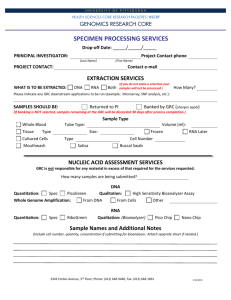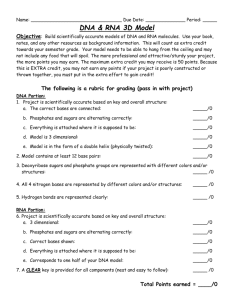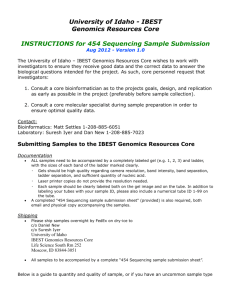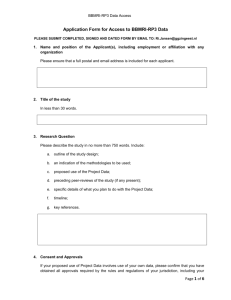Sample Specifications - IMBB - Foundation for Research and
advertisement
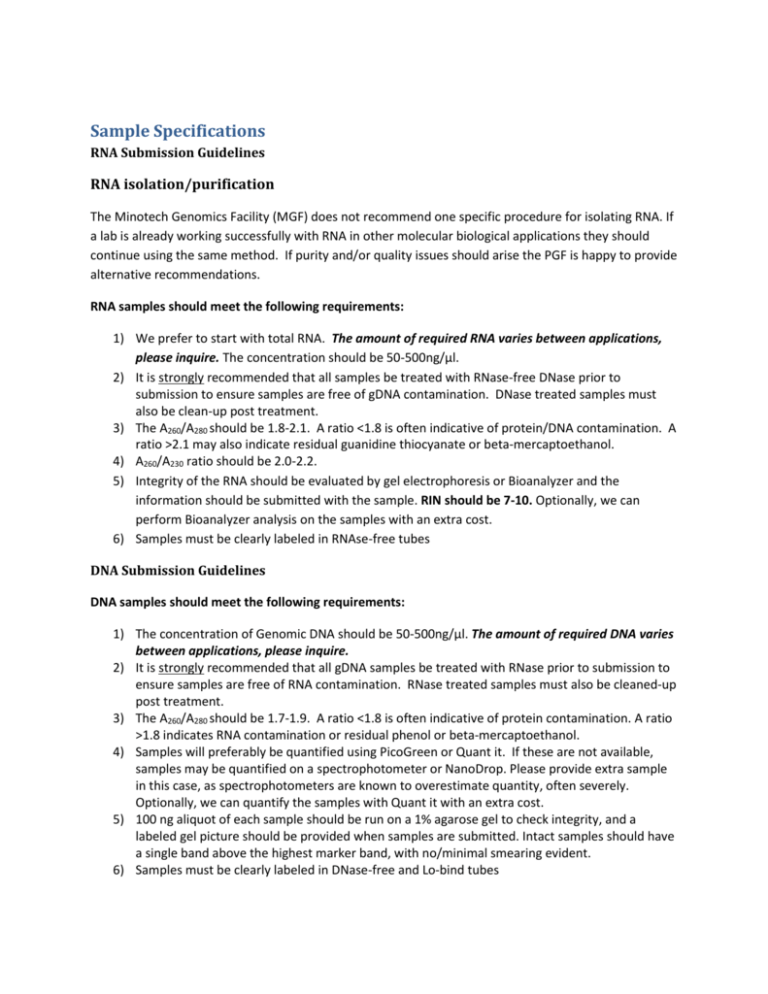
Sample Specifications RNA Submission Guidelines RNA isolation/purification The Minotech Genomics Facility (MGF) does not recommend one specific procedure for isolating RNA. If a lab is already working successfully with RNA in other molecular biological applications they should continue using the same method. If purity and/or quality issues should arise the PGF is happy to provide alternative recommendations. RNA samples should meet the following requirements: 1) We prefer to start with total RNA. The amount of required RNA varies between applications, please inquire. The concentration should be 50-500ng/μl. 2) It is strongly recommended that all samples be treated with RNase-free DNase prior to submission to ensure samples are free of gDNA contamination. DNase treated samples must also be clean-up post treatment. 3) The A260/A280 should be 1.8-2.1. A ratio <1.8 is often indicative of protein/DNA contamination. A ratio >2.1 may also indicate residual guanidine thiocyanate or beta-mercaptoethanol. 4) A260/A230 ratio should be 2.0-2.2. 5) Integrity of the RNA should be evaluated by gel electrophoresis or Bioanalyzer and the information should be submitted with the sample. RIN should be 7-10. Optionally, we can perform Bioanalyzer analysis on the samples with an extra cost. 6) Samples must be clearly labeled in RNAse-free tubes DNA Submission Guidelines DNA samples should meet the following requirements: 1) The concentration of Genomic DNA should be 50-500ng/μl. The amount of required DNA varies between applications, please inquire. 2) It is strongly recommended that all gDNA samples be treated with RNase prior to submission to ensure samples are free of RNA contamination. RNase treated samples must also be cleaned-up post treatment. 3) The A260/A280 should be 1.7-1.9. A ratio <1.8 is often indicative of protein contamination. A ratio >1.8 indicates RNA contamination or residual phenol or beta-mercaptoethanol. 4) Samples will preferably be quantified using PicoGreen or Quant it. If these are not available, samples may be quantified on a spectrophotometer or NanoDrop. Please provide extra sample in this case, as spectrophotometers are known to overestimate quantity, often severely. Optionally, we can quantify the samples with Quant it with an extra cost. 5) 100 ng aliquot of each sample should be run on a 1% agarose gel to check integrity, and a labeled gel picture should be provided when samples are submitted. Intact samples should have a single band above the highest marker band, with no/minimal smearing evident. 6) Samples must be clearly labeled in DNase-free and Lo-bind tubes Ch-IP samples Recommendations ChIP-seq is one of the most technically complicated Next Generation Sequencing projects to undertake, and is entirely dependent upon the quality of sample submitted for library preparation. 1) Submit at least 100ng of each input and the entirety of each IP sample. Quantify your IP sample using PicoGreen or Quant-it. If you don’t have access to these dyes, please submit IPs without quantifying; we do it as part of our initial QC and will send you the results. 2) Each submitted sample should be sheared between 200-500 bp. We will assess this by Agilent Bioanalyzer. 3) Each Input and IP sample should be reverse crosslinked and the DNA precipitated and resuspended in either water or 10mM Tris pH 7-8. See also: ChIP-seq analysis of protein–DNA interactions on the Ion Proton System (https://tools.lifetechnologies.com/content/sfs/brochures/ChipSeq-Application-Note-CO28266.pdf) Shipping: 1) A filled out submission form must accompany all shipments. 2) All items shipped should be sealed in a plastic bag. 3) Sample should be shipped on dry ice overnight to Minotech Biotechnology Genomics Facility Institute of Molecular Biology and Biotechnology (IMBB) Foundation for Research and Technology - Hellas (FORTH) Nikolaou Plastira 100 GR-70013, Heraklion, Crete, Greece
